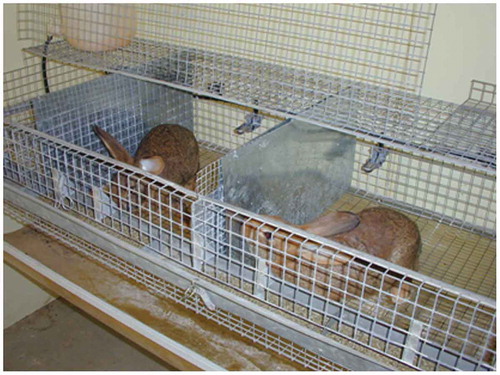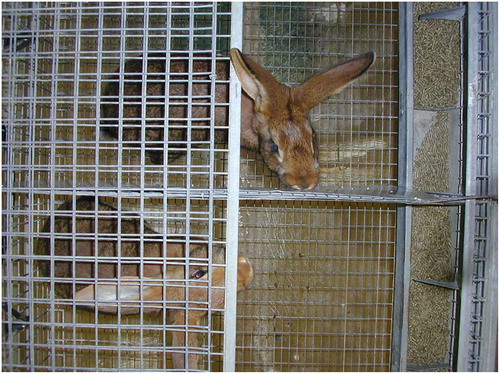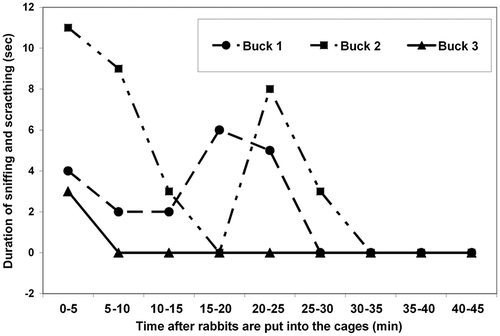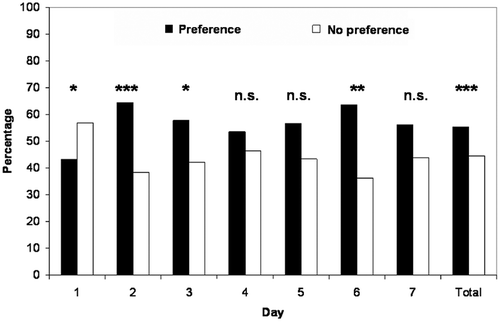Abstract
To assess the sex influence on sniffing behavior of rabbits, sets of three rabbits each were located for seven days in contiguous cages divided by a metal wall with holes that prevented the neighboring rabbits to see each other. A buck was located in the central cage, with a doe at each side. Rabbit behavior was video recorded to observe animals sniffing with the muzzle near the wall. The bucks displayed an olfactory preference towards one of the two does, which decreased in few days. The significance was p < 0.01 for the first three days, it lowered to p < 0.05 in the next three days and from the seventh, it turned insignificant (p > 0.05). The interest of bucks towards the does was also characterized by a frenetic scratching of the separation wall, contemporary with intense sniffing, displayed only for the first 35 min of the first day. The sniffing behavior of does at the central cage housing the male was not so marked as in bucks, and it progressively changed across the trial (p < 0.01). In conclusion, rabbits establish a transitory sex-oriented olfactory relationship with the conspecifics housed in contiguous cages, which looks no longer necessary once the rabbits have recognized each other.
Public Interest Statement
Public concerns against industrial farming include opposition to cage-based systems, under the feeling that impede the social interactions among the animals. This investigation demonstrates that rabbits kept in contiguous individual cages maintain social relationships by olfactory activity. This was confirmed by a sniffing activity near the wall, maintained for some days when rabbits were located in cages separated by solid walls with holes that prevented them to see each other but allowed smelling. To check whether also an olfactory sexual relationship exists, a trial was performed by putting male rabbits between two females in adjacent cages. Male rabbits displayed a preference towards one of the females. The sniffing behavior of females was not so marked as in male rabbits. In both sexes, this sex-oriented behavior decreased during the first week, suggesting it is no longer necessary once the rabbits have recognized each other because the smell is felt anyway.
1. Introduction
The lack of social relationship is considered a welfare constraint in the industrial rabbit keeping system, in which each doe has its own cage, disposed as a part of a row along the building (Trocino & Xiccato, Citation2006; Verga, Citation2000). To maintain visual contacts among animals is specifically recommended by Boers et al. (Citation2002), but it was ascertained that a mutual visual relationship is always established, at least among does located in single cages in the same row (Negretti, Albani, & Finzi, Citation2004; Negretti, Bianconi, & Finzi, Citation2008). As the importance of olfactory stimuli to elicit specific behaviors, mainly in sexual relationships, is well known (Mainardi, Citation1992), this possibility has also been investigated and it was possible to prove that does sniff at each other, though this behavior is observed only when the animals are recently located in contiguous cages and it tends to disappear in the lag of about a week (Negretti, Bianconi, & Finzi, Citation2010). Following this line of investigation, aimed at better understanding how rabbits can maintain a social relationship though located in single cages, a research was carried out to study what peculiar olfactory behavior can be observed when a buck is located in a cage between two does. This experiment is aimed only to ascertain if sniffing behavior is influenced by sex of the animals, since males are normally located together, rather than among does, in the industrial buildings.
2. Materials and methods
2.1. Experimental procedure
The experiment was performed utilizing the same cage set utilized in previous trials (Figure ; Negretti et al., Citation2004, Citation2008, Citation2010). The experimental set was formed by a row of three contiguous cages located in the open air in an orchard (Viterbo province, Italy; 42° 25′ N, 12° 06′ E) to avoid the pheromones saturation of closed environments. The cages where limited by a solid tin wall that impaired the animals to see each other, while small holes (diameter 1.5 mm; 4 lines; 6 cm distance; 7 holes per line) allowed the olfactory perception of the contiguous animals. Adult rabbits (Leprino of Viterbo breed; ANCI-AIA, Citation2006), seven-month-old, were located into the cages in the same time. A buck was located in the central cage, while a doe was disposed at each side. This is not a disposition normal in industrial systems where sexes are raised in different areas, but, in this case, the aim was to check if does showed an interest for the male, sniffing towards the walls limiting the central cages and if the bucks showed same preference for one of the does or not.
Figure 1. Experimental cage consisting of three contiguous individual compartments delimited by a solid tin wall that impair the animals seeing each other, and provided with small holes allowing the olfactory perception of the contiguous rabbits

Animal behavior was recorded 24 h round, for seven consecutive days, with three replications and new animals each replication. A three times replication was sufficient to demonstrate that sniffing relationships exist and to show that behavior is strongly affected by individuality, as in previous experiments where behavioral response was involved (Finzi, Ciorba, & Macchioni, Citation2001; Negretti et al., Citation2004, Citation2008, Citation2010). Photograms were observed for 1 min each 5 min to a total of 2,184 observations per each rabbit, and single or reciprocal sniffing at the wall was recorded. Records were also analyzed for male behavior, which were seen scratching actively at the wall as if trying to go through it. In this case, the bucks’ behavior was checked for 45 consecutive minutes, just after putting the animals in the cages. Longer observation time was not necessary because this behavior was, in case, very immediate and transitory.
2.2. Statistical analysis
In order to analyze, for each single day and for the whole period of observation, (1) bucks showing an olfactory preference for one of the does located at both sides, and (2) does showing or not an olfactory preference for the buck located at the central cage, goodness-of-fit χ 2 tests were performed. For these tests, the null hypothesis that animals preferred each one of both alternatives in the same proportion was assumed. To analyze the change of these preferences across the trial period, χ 2 tests on contingency tables were performed. These analyses (Ferrán, Citation1996) were performed according to SPSS 15.0 (SPSS Inc., Citation2006).
3. Results and discussion
It was observed that all bucks, despite individual variability, showed a significant olfactory preference for one of the does located at both sides (near 70%; p < 0.001; Table ; Figure ). This behavior was persistent for the whole week that lasted the trial, in the sense that it did not change across the trial (χ 2 = 4.182; p = 0.653), but it tended to decrease slowly. The preference was very significant (p < 0.01) for the first three days (72.8 vs. 27.2%), and it lowered to p < 0.05 in the next three days (66.4 vs. 33.6%). On the seventh day, the difference was still evident (57.6 vs. 42.4%), but it lost significance (p = 0.384).
Table 1. Frequency of sniffing occurrences of males showing a preference for one of the does set at both sides of the buck’s cage
Figure 2. A buck is displaying an olfactory behavior towards a doe located in a contiguous cage delimited by a solid tin wall provided with small holes

The does’ sniffing interest for the conspecific located in the contiguous cage (Negretti et al., Citation2010) was more marked and intense when males were involved. Nevertheless, as already shown, sniffing at the wall tended to diminish after the rabbits recognized each other, they need no longer any specific behavior to smell the conspecific in neighboring cages.
The preference for one of the does was marked and persistent for all the three bucks, while in the previous trial (Negretti et al., Citation2010), this behavior was shown, though less marked, only by one of the does when animals of the same sex where tested. The preference for one of the does found in the present trial confirms that rabbits utilize olfactory communication signals for identification of mates (Marai & Rashwan, Citation2003).
The interest of bucks towards the does was also shown by a typical behavior of frenetic scratching at the separation wall, contemporary with intense sniffing (Figure ), mainly when the does were near to the wall, frequently also sniffing at it. This behavior was very transient because it was observed only for the first 35 min of the first day at most. Probably it depends on the time the buck gets frustrated for the unsuccessful scratching behavior. Also, individuality was evident as shown in Figure ; one subject stopped scratching at the wall nearly immediately, while another persisted in his effort for half an hour.
Figure 3. Duration of occurrence of males sniffing and scratching at the separation wall after being put into the cages

The behavior of does was not so marked as for males (Figure ), and it changed across the trial (χ 2 = 20.517; p = 0.002). Nevertheless, except the first day, when the behavior was more explorative than sex oriented, sniffing at the central cage was observed where the buck was located. Sometimes the significance level (p < 0.05) was reached in single days, but overall, the significance was high (p < 0.01).
4. Conclusions
The trial showed that rabbits establish an olfactory relationship with the conspecifics located in contiguous cages. This relationship is sex oriented. It looks transitory because when the animals have recognized each other by sniffing, this behavior is no longer necessary as olfactory stimuli, differently by visual ones, can be perceived also when the animal are not specifically sniffing and even if they have the heads oriented in different directions. For this reason, visual relationship can be observed as a persistent social activity easily recognized; on the contrary, the olfactory relationship, though obviously persistent, can be studied only for a shorter period (days or even minutes), just after the rabbits have been located into contiguous cages.
Cover image
Source: Author.
Additional information
Funding
Notes on contributors
Alessandro Finzi
The activity of the research group of the Rabbit Unconventional Keeping Experimental Centre at Viterbo (Italy) is mainly related to alternative keeping systems to improve rabbit welfare, to minimizing the production costs, to produce high-quality meat in the industrialized Countries, and to improve food security in the developing ones. The research reported in this paper pertains to a line aimed at a better understanding of the rabbit ethology under industrial farming conditions. Individually caged rabbits are considered deprived of social relationship, but previous trials have shown that a visual relationship is maintained. The present research demonstrates that rabbits establish olfactory relationships even though they are kept in individual cages.
References
- ANCI-AIA . (2006). Norme tecniche del libro genealogico e del registro anagrafico della specie cunicola [Technical standards of the rabbit species stud book]. Rome: Author.
- Boers, K. , Gray, G. , Love, J. , Mahmutovic, Z. , McCormick, S. , Turcotte, N. , & Zhang, Y. (2002). Comfortable quarters for rabbits in research institutions. In V. Reinhardt & A. Reinhardt (Eds.), Comfortable quarters for laboratory animals (pp. 43–49). Washington, DC: Animal Welfare Institute.
- Ferrán, M. (1996). SPSS para Windows. Análisis estadístico [SPSS for windows. Statistical analysis]. Madrid: Osborne-McGraw-Hill.
- Finzi, A. , Ciorba, P. , & Macchioni, P. (2001, May 23–24). Evaluación comparada del bienestar del conejo en sistemas alternativos de cría [Comparative evaluation of rabbit welfare in alternative breeding systems]. In Proceedings of the XXVI Symposium de Cunicultura de ASESCU-I Symposium Ibérico de Cunicultura APEZ-ASPOC (pp. 164–167). Aveiro, Portugal.
- Mainardi, D. (1992). Dizionario di Etologia [Dictionary of ethology]. Turin: Einaudi.
- Marai, F. M. , & Rashwan, A. A. (2003). Rabbits behaviour under modern commercial production conditions—A review. Archiv Tierzucht , 46 , 357–376.
- Negretti, P. , Albani, A. , & Finzi, A. (2004, September, 7–10). Location and social behaviour of young rabbits bucks. In Proceedings of the 8th World Rabbit Congress (pp. 1257–1263). Puebla, Mexico.
- Negretti, P. , Bianconi, G. , & Finzi, A. (2008, June, 10–13). Mutual visual relationships of rabbits raised in individual cages. In Proceedings of the 9th World Rabbit Congress (pp. 1213–1216). Verona, Italy.
- Negretti, P. , Bianconi, G. , & Finzi, A. (2010). Short communication: Mutual olfactory relationships in rabbits raised in individual cages. World Rabbit Science , 18 , 33–36.10.4995/WRS
- SPSS Inc . (2006). Manual del Usuario de SPSS Base 150 [SPSS base 15.0 user's guide]. Chicago, IL: Author.
- Trocino, A. , & Xiccato, G. (2006). Animal welfare in reared rabbits: A review with emphasis on housing systems. World Rabbit Science , 14 , 77–93.
- Verga, M. (2000, July, 4–7). Intensive rabbit breeding and welfare: Development of research, trends and applications. In Proceedings of the 7th World Rabbit Congress (pp. 491–509). Valencia, Spain.

